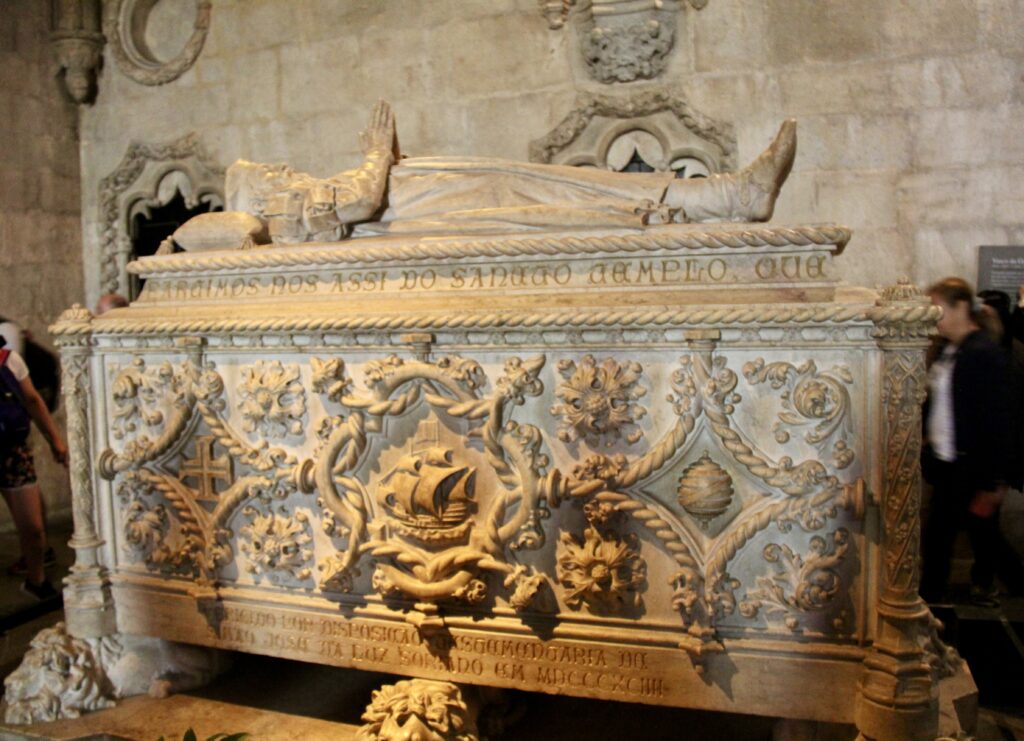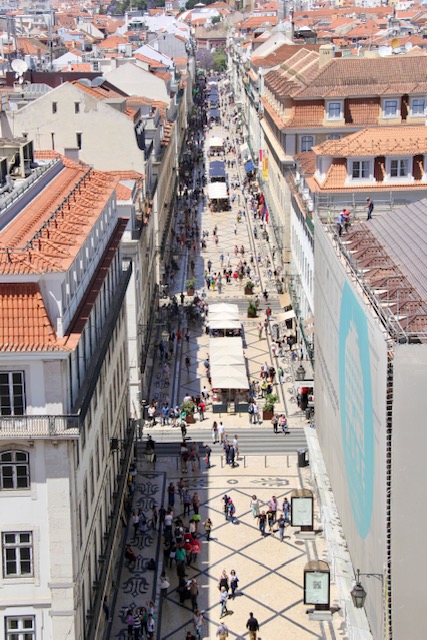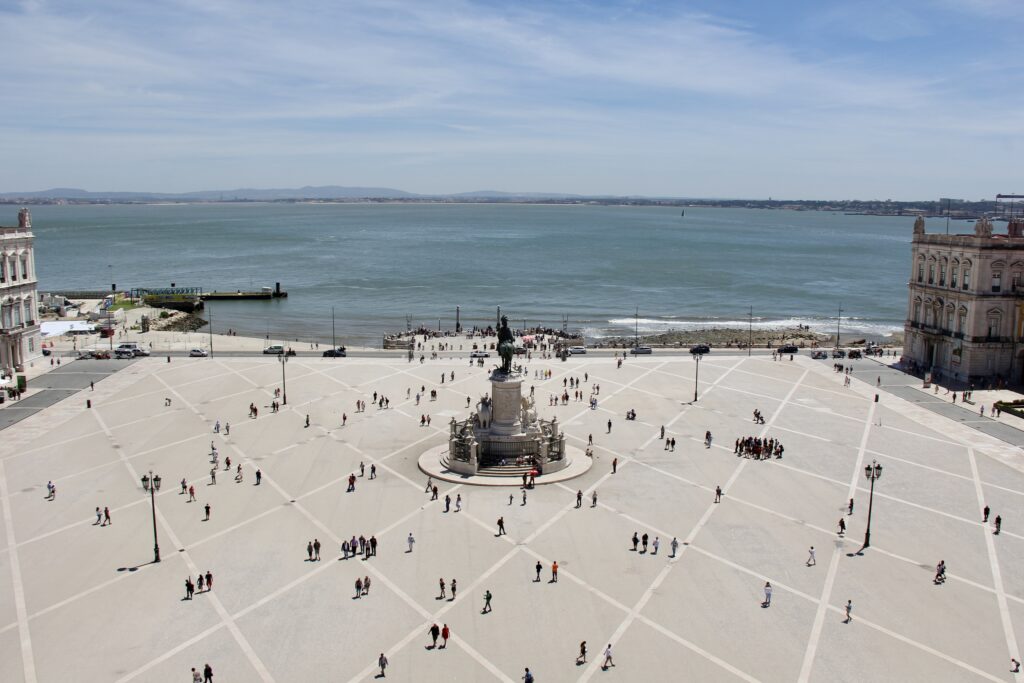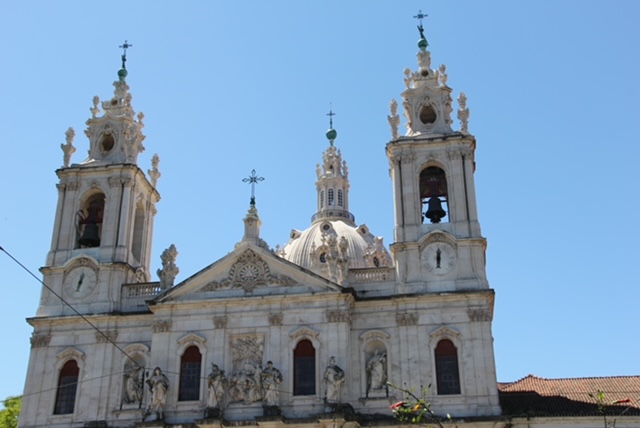We bagan the day with a visit to the historical UNESCO World Heritage Site Torre de Belém. Lisbon to Torre de Belem is less than 20 min by car. Once there, you can also visit Jeronimos monastery and the Monument to Discoveries which are within walking distance.
Torre de Belém – Built in 1515-1521, this historical monuments and UNESCO World Heritage Site is located where the Tagus River meets the Atlantic Ocean. The tower is one of the main symbols of Portugal’s global expansion during the so-called Age of Exploration (beginning in the mid-to-late 15th century), when Europeans increasingly traveled to different parts of the world to expand their knowledge of and control over resources, people, and lands. The Tower’s purpose was to protect the entrance to Lisbon’s port, and was designed in a way that “no ship could pass by without being seen.”

You can climb the steep spiral staircase to the top-floor tower terrace, for a fine view of the waterfront esplanade and the river.



Padrão dos Descobrimentos(Monument to the Discoveries) – Dominating the Belém waterfront and a few yards from Torre de Belem is the angular Monument to the Discoveries, an enormous monolith that leans over the River Tagus. This landmark structure was built in 1960 to commemorate the 500th anniversary of the death of Henry the Navigator. The statues set along both sides of the monument include Vasco da Gama, Fernão de Magalhães, and Pedro Álves Cabral. Henry himself stands at the fore, caravel in hand. You can take an elevator to the top of the monument for a view of the riverfront and the surrounding vicinity.


You can see Torre de Belem from the top and Monument and vice versa.


Jerónimos monastery – Across the road from Torre de Belém and Monument to the Discoveries is another UNESCO World Heritage Site, the 16th century monastery built to honor Vasco da Gama’s epic 1498 voyage to India. Jerónimos is as much a symbol of the wealth of the Age of Discovery as it is a house of worship and its construction was mostly funded by trade in the spices brought back by da Gama.

One can spend hours admiring the inside and outside of this architectural masterpiece. The cloisters are magnificent, with each column differently carved with coils of rope, sea monsters, coral, and other sea motifs, evocative of that time of world exploration at sea. Vasco da Gama’s tomb lies just inside the entrance to Santa Maria church.



Arco da Rua Augusta (A Triumphal Arch) – This 19th-century memorial arch was built to commemorate the city’s rebirth after the 1755 earthquake. It also can be considered as an entrance to Lisbon’s huge and impressive riverfront square, Praça do Comércio. One can take an elevator to the floor from where you have to climb up a steep spiral staircase to reach the terrace. From here, you can take in the view of Praça do Comércio square and the river on the south and the view of Lisbon’s downtown to the North.



Praça do Comércio – This is one of the largest and beautiful squares in all of Europe. In the centre of the Square, and facing the river, there is a statue of José I, mounted on his horse Gentil, and was unveiled on 6th June 1775, the king´s birthday. The square has the Lisboa Story Center which introduces/narrates the history of Lisbon.

Elevador de Santa Justa – The metal structure looming over the rooftops of Lisbon’s downtown is the odd-looking Santa Justa Lift. This 19th century industrial-era neo-Gothic elevator reminds one of Eiffel Tower and there is a connection – the French architect Raoul Mésnier du Ponsard, an apprentice of Gustave Eiffel, designed the elevator, which was inaugurated in 1901. Historically the Elevador de Santa Justa was an invaluable part of Lisbon’s transport network connecting the Baixa with the Largo do Carmo in the Bairro Alto neighborhood, but today it is primarily a tourist attraction and an expensive 5.3 Euros to ride to the top.


Once you reach the top, you get a great view of the Baixa district. At the rear of the lift, a walkway leads around to the ruins of Igreja do Carmo.

Igreja do Carmo – The beautiful ruins of the Carmo Convent was built in 1389 and was Lisbon’s biggest church until the devastating earthquake of 1755 caused the roof to collapse upon the entire congregation. 85% of the city was destroyed and anywhere from 60 – 100,000 people died. Although a massive reconstruction program took place in the years after the earthquake, a deliberate and thoughtful decision was made to leave the ruins standing in this state to commemorate the loss and destruction. What you see today are the exposed arches standing naked, against the sky.

Praça Dom Pedro IV – Also called Praça do Rossio, this plaza used to be the place for executions, bullfights, and demonstrations, among other things. Today, it is a wonderful place to relax for a while, as there are some trees and some beautiful fountains. The first thing to notice is the waves of black and white cobblestones lining the streets that adorn the square, a tribute to traditional Portuguese tile art. At the center of this enchanting mosaic is an imposing statue of Dom Pedro IV.


Castelo de São Jorge – St. George’s Castle is located on a hill overlooking Lisbon. Human occupation of the castle hill dates to at least the 8th century BC while the oldest fortifications on the site date from the 2nd century BC. The hill on which Saint George’s Castle stands has played an important part in the history of Lisbon, having served as the location of fortifications occupied successively by Phoenicians, Carthaginians, Romans, and Moors, before its conquest by the Portuguese in the 1147 Siege of Lisbon. Since the 12th century, the castle has variously served as a royal palace, a military barracks, home of the Torre do Tombo National Archive, and now as a national monument and museum. You will be rewarded with views of the city, the River Tagus, and the distant Atlantic Ocean.




Se Cathedral – Built in 1147, the cathedral has survived many earthquakes and has been modified, renovated and restored several times. It is currently a mix of different architectural styles and has been classified as a National Monument since 1910.


Basílica da Estrela – The gorgeous white dome of the Basílica da Estrela (Star Basilica) can be seen from most places in Lisbon. The church is one of the Lisbon’s grandest and was commissioned by Queen Maria I, daughter of King José I. Construction of the basilica began in 1779 and was completed in 1790. The church is located in a hill in what was at the time the western part of Lisbon




Aqueduto das Águas Livres – The Aqueduto das Águas Livres is an important engineering work from the 18th century, built to supply water to the city of Lisbon and its surrounding areas. It covers a total length of 14 km from its main source in Caneças to its end at the reservoir of Mãe d’Água das Amoreiras. The section that spans the valley of Alcântara consists of 35 arches, including the world’s highest stone arch, 65 m high and 32 m wide. The aqueduct was only completely deactivated as late as 1973 and thereafter opened to the public in 1986. Nowadays, the Water Museum, to which it belongs, organizes visits to the inside of the aqueduct. It is possible to walk across the aqueduct in both directions along the walkways or “passesios dos across’.

Other attractions in/near Lisbon :
Church and Museu de São Roque – The church and museum of São Roque in Bairro Alto combine to offer an absorbing cultural experience. Founded in the late 16th century by the Jesuit Order, the church is richly embellished with marble, azulejos, and gilded woodwork. It also has a series of side chapels, one of which, the Capela de São João Baptista, simply dazzles the onlooker with its ornate decoration. Housed in a 17th-century cloister, this museum offers a sizable collection of Portuguese sacred art.
Day trip to Sintra – One of the best day trips out of Lisbon is a visit to, a direct 40-minute rail journey from the city center. Nestling in the foothills of the rugged Serra de Sintra this place has a mighty Moorish castle dating from the 8th century. The historic old town (Sintra-Vila), is also worth exploring on this trip. Once the summer retreat for the Kings and Queens of Portugal, Sintra is a World Heritage Site.